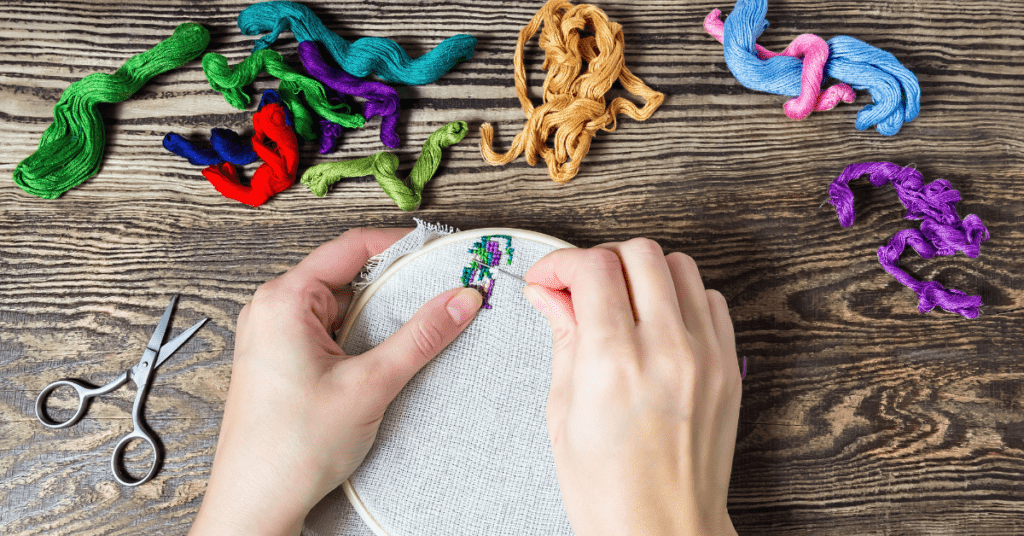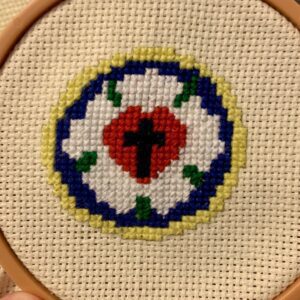By Anne Wickland
I would not call myself an artist or especially good at art. I can decently craft, making friendship bracelets or decorating cards, but I do not call myself an artist. This makes it all the more funny to me that I have found arts and crafts as a space where I nurture my relationship with God.
This past summer I took a course from CTU (Catholic Theological Union) Saints and Prophets and I was pleasantly surprised to learn that the course was art-based, having our instructor Brother Mickey McGrath teach the course using his own artwork and pictures from his travels. During these lectures I would use my bullet journal to write down quotes and phrases that inspired me or that I wanted to meditate on later. Each night we were given some sort of artistic assignment such as decorating our own mandalas or creating a protest poster. We were encouraged with each of these assignments to use the activity as an outlet of prayer or as some sort of spiritual practice. I would put on one of my Christian music playlists, one of them aptly named Jesus Jams, and let the Holy Spirit guide me and my multicolored pens in drawing and writing. In these moments of creativity, whether they involved cross stitch, creatively journaling, or simply coloring, I found myself having feelings of release, as if I had just let out a big sigh and settled into my cozy little corner of God’s presence.
Having had this experience of using arts and crafts as a spiritual practice, I wanted to share that in my internship congregation. This past winter I coordinated an Advent devotional for Christ on Capitol Hill based around the theme “almost, but not yet”, sitting in the liminal space that Advent invites us into. There’s always an in-between time. Instead of jumping to Christmas or Easter, I like that we’re given the time to be in such a liminal space during seasons like Advent and Lent. And I think that these in-between times resonate with where we are right now. That sense of anticipation and not knowing when or what’s next is relatable to a lot of people right now after over a year of COVID-time. With this Advent devotional project, I invited people to be creative, not thinking of a devotional as only a verse, reflection, and prayer, but that a piece of a watercolor, art, or a poem can be a devotional too. Giving people the permission to be creative led to some great theological conversations around hope, lament, and uncertainty. We’re in this in-between time and sometimes words fail. Although words may fail, God speaks in those moments of uncertainty, and so much can be said through art.
If you would like to introduce creative devotionals to your community, here are some other practices to try:
Coloring
I have a coloring book based on the hymn “All Things Bright and Beautiful” that I like to use for spiritual practice. It’s been great for me to color during worship, letting the spirit guide me. For Sunday School, we’ve used Children’s Illustrated Ministry, where each week has a bulletin filled with activities and at least one coloring page based upon that week’s texts. Here is an example of a Children’s Time I led where I shared a time-lapse video of me coloring while the Psalm was read.
Bullet journaling/creative journaling
When listening to sermons or reading scripture, I tend to write out words or phrases that I connect with or that capture my imagination. Sometimes I’m very intentional about slowing down and really focusing on how I’m writing the word or which color pen I use.
Cross-stitch
Within the last year I have also picked up cross-stitch and I like how cathartic it can be. I jokingly tell people that it feels great to stab something a bunch of times and something beautiful comes from it, but there is truth in that—you can turn frustrations into art. There’s something cathartic in praying out frustrations and complex emotions through art.
Last year for a few of my seminary classes, I was able to turn in a cross-stitch piece as my final project. For my Lutheran confessions course, over Holy Week I created a Luther Rose. In the project write up I described using this outlet as a way to teach Lutheran theology and the meaning behind the rose for a confirmation class. For my saints and prophets course I did a small design of pansies. Many of the saints we discussed used gardens and nature imagery to describe their relationship with God and as someone whose faith a call to ministry was fostered as a summer camp counselor, I relate to that.
Writing scripture
Similar to bullet/creative Journaling, writing out scripture has been a spiritual practice for centuries. Many monasteries had specific rooms (scriptoriums) where monks would transcribe, copy and illuminate manuscripts, for practical and spiritual purposes. This past summer I was a part of the Chicago Illuminated Scripture project where throughout the Metro Chicago Synod people were invited to sign up for a chapter, mainly gospel texts, to handwrite.
Painting in community
During the first week of Easter, we were invited to paint an Easter scene with artist Paul Oman. Paul led a very friendly, fast-paced, grace-filled virtual class. Together with Pastor Joy and family, we joined in from a dining room table. Others joined with a confirmation class or small group of painters. I doubt that any of us felt totally comfortable—it was a stretch-out-of-our-comfort-zone art activity for most of us—and also, it was a way to connect with paint, brush, canvas and each other that bore beautiful, diverse results.
Meditate on the art of others
Although our congregation has not been worshipping in the sanctuary for over a year, two banners hang for most of the year in the front of the worship space at Christ on Capitol Hill. They replicate the mural by DeAnne L. Parks that is on the front doors of our church, featuring the Tree of Life surrounded by our faith community—ancient, historical, present and future. The people are indigenous and global. You can make out creatures and Bible stories. Many of the images are open to multiple interpretations. For example, viewers may wonder about a piece if it is a pieta, the Good Samaritan, both, or neither? Every week, we know those doors speak to those who glance at them from the crosswalk or are waiting at a red light, and they speak to the community that worships inside from week to week. They are a beautiful thing and just as Jesus commended the woman who anointed him for giving him a beautiful gift, art blesses us with its beauty, power and presence. It helps us be present. It is a gift.
About the author
Anne Wickland serves as Vicar at Christ on Capitol Hill in Saint Paul, MN. She is graduating with a Master of Divinity degree from Lutheran School of Theology at Chicago this Spring and is in the ELCA candidacy process towards ordination in Word and Sacrament. This past summer she took a Saints & Prophets course from Catholic Theological Seminary primarily taught using art, which encouraged the use of art as a form of spiritual practice. This course influenced her internship project–a community Advent Devotional where congregants were encouraged to use art (poems, watercolor, photography) as a devotion.


